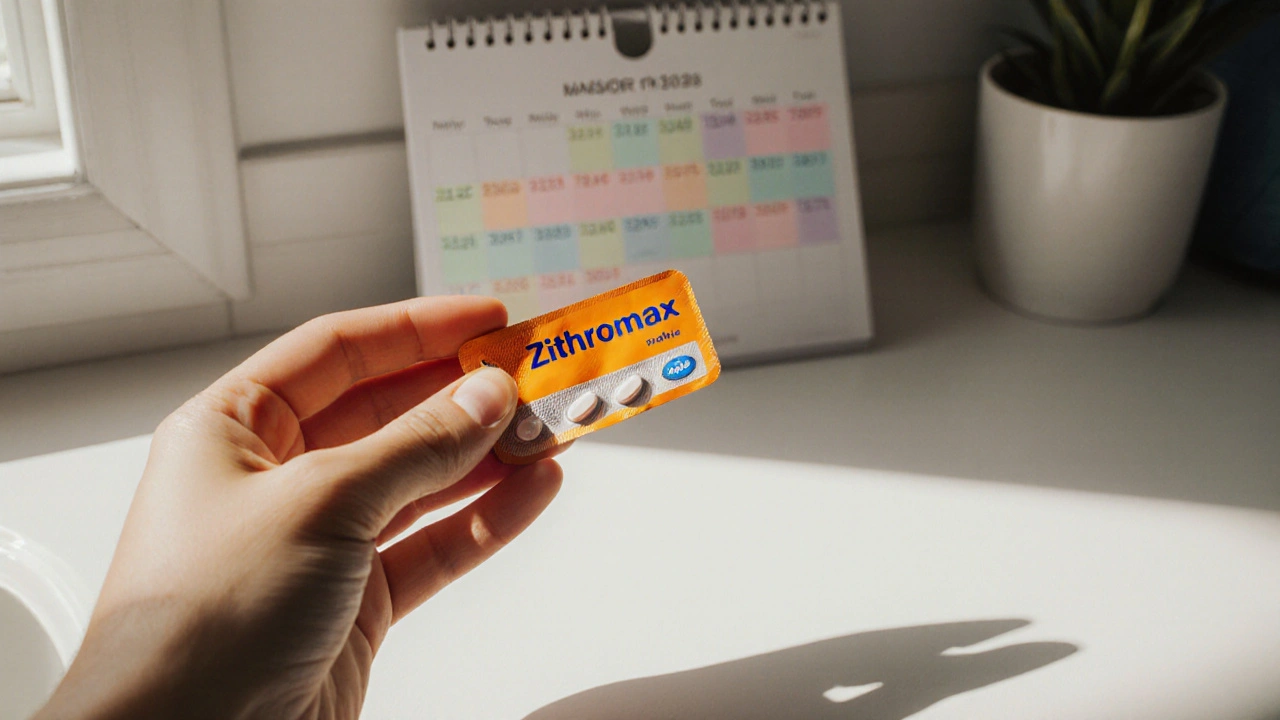Zithromax vs Alternatives: Antibiotic Selector
When you need a quick fix for a bacterial infection, the big question is often: Azithromycin alternatives-should you stick with Zithromax or consider something else? This guide breaks down the most common substitutes, compares how they perform, and helps you decide what’s right for your situation.
Key Takeaways
- Zithromax is a macrolide antibiotic prized for its short course and good tissue penetration.
- Amoxicillin, Doxycycline, Clarithromycin, and Levofloxacin cover similar infections but differ in spectrum, side‑effects, and dosing convenience.
- Choosing the right drug depends on infection type, patient age, allergy history, and potential drug interactions.
- Always discuss alternatives with a healthcare provider, especially if you have liver disease, heart rhythm issues, or are pregnant.
What Is Zithromax (Azithromycin)?
Zithromax is a broad‑spectrum macrolide antibiotic (generic name azithromycin) that works by stopping bacterial protein synthesis. It’s taken as a single daily dose for three to five days, which makes it popular for ear infections, strep throat, community‑acquired pneumonia, and certain sexually transmitted infections.
How Zithromax Works
Azithromycin binds to the 50S subunit of bacterial ribosomes, blocking the translocation step of protein elongation. This action is bacteriostatic-meaning it halts bacterial growth, giving the immune system a chance to clear the infection.
Typical Uses for Zithromax
- Upper respiratory infections (e.g., sinusitis, bronchitis)
- Community‑acquired pneumonia caused by Streptococcus pneumoniae or Haemophilus influenzae
- Skin infections like cellulitis
- Chlamydia trachomatis and gonorrhea (single‑dose therapy)
- Travel‑related diarrhoea (e.g., Campylobacter)
Common Alternatives to Zithromax
When clinicians consider a swap, they usually look at the infection’s likely bacteria, patient tolerance, and dosing convenience. Below are the four most frequently discussed alternatives.
Amoxicillin
Amoxicillin is a penicillin‑type β‑lactam antibiotic that interferes with bacterial cell‑wall synthesis. It’s the go‑to for many ear, nose, and throat infections because it’s cheap and well‑tolerated. However, resistance is rising in some regions, especially for H. influenzae.
Doxycycline
Doxycycline is a tetracycline antibiotic that blocks bacterial protein synthesis by binding to the 30S ribosomal subunit. It shines for atypical pneumonia, Lyme disease, and acne, but it can cause photosensitivity and is not recommended for pregnant women or children under eight.
Clarithromycin
Clarithromycin is another macrolide similar to azithromycin but with a longer half‑life and a higher potential for drug interactions. It’s often used for Helicobacter pylori eradication regimens and certain Mycobacterium infections.
Levofloxacin
Levofloxacin is a fluoroquinolone antibiotic that inhibits bacterial DNA gyrase and topoisomerase IV. It offers excellent lung penetration and works against many resistant strains, but concerns about tendon rupture, QT prolongation, and CNS effects limit its routine use.
Side‑Effect Profiles Compared
Every antibiotic carries risks. Below is a quick rundown of the most common adverse events for each drug.
- Zithromax: mild GI upset, rare liver enzyme elevation, possible QT interval lengthening.
- Amoxicillin: diarrhea, rash, rare allergic anaphylaxis.
- Doxycycline: photosensitivity, esophageal irritation, possible tooth discoloration in children.
- Clarithromycin: bitter taste, strong drug‑interaction potential (CYP3A4 inhibition), GI upset.
- Levofloxacin: tendonitis/tendon rupture, QT prolongation, dizziness, risk of Clostridioides difficile infection.
Dosage Convenience
Convenience can dictate adherence. Here’s how the regimens stack up:
- Zithromax - 500mg on day1, then 250mg daily for 4days (or 1g single dose for STDs).
- Amoxicillin - 500mg three times daily for 7‑10days.
- Doxycycline - 100mg twice daily for 7‑14days (or 200mg once daily for certain infections).
- Clarithromycin - 500mg twice daily for 7‑14days.
- Levofloxacin - 750mg once daily for 5‑7days (sometimes 500mg).
Cost Considerations (2025 US Prices)
Pricing can vary by country, but a general snapshot for a typical course in the United States:
- Zithromax (generic azithromycin) - $10‑$15 for a five‑day pack.
- Amoxicillin - $5‑$10 for a 10‑day supply.
- Doxycycline - $8‑$12 for a two‑week supply.
- Clarithromycin - $15‑$25 for a two‑week supply (brand cost higher).
- Levofloxacin - $20‑$30 for a five‑day pack.

Comparison Table
| Antibiotic | Class | Typical Infections Treated | Dosing Schedule | Common Side Effects | Cost (US, 2025) |
|---|---|---|---|---|---|
| Zithromax (Azithromycin) | Macrolide | Respiratory, skin, STI, travel‑diarrhoea | 1‑day load + 4‑day taper | GI upset, QT prolongation | $10‑$15 |
| Amoxicillin | Penicillin (β‑lactam) | Otitis media, sinusitis, strep throat | 3× daily for 7‑10days | Diarrhea, rash, allergy | $5‑$10 |
| Doxycycline | Tetracycline | Atypical pneumonia, Lyme, acne | 2× daily for 7‑14days | Photosensitivity, esophagitis | $8‑$12 |
| Clarithromycin | Macrolide | H. pylori, MAC infections | 2× daily for 7‑14days | Bitter taste, drug interactions | $15‑$25 |
| Levofloxacin | Fluoroquinolone | Complicated pneumonia, UTIs | 1× daily for 5‑7days | Tendon rupture, QT issues | $20‑$30 |
When to Choose Zithromax Over Alternatives
Pick Zithromax if you need a short, once‑daily regimen and the likely pathogen is susceptible to macrolides. It’s especially handy for patients who struggle with multi‑dose schedules or have a penicillin allergy.
When an Alternative Might Be Better
- Penicillin‑susceptible infections: Amoxicillin is cheaper and has a narrower spectrum, reducing resistance pressure.
- Atypical organisms: Doxycycline or levofloxacin cover Mycoplasma and Chlamydia more reliably.
- Risk of QT prolongation: Avoid macrolides if the patient has a known heart rhythm disorder; levofloxacin also has QT risk, so a β‑lactam may be safest.
- Pregnancy: Amoxicillin and certain cephalosporins are preferred; azithromycin is Category B but still used cautiously.
Talking to Your Healthcare Provider
Bring these points to the appointment:
- List of current medications (to check for drug interactions, especially with clarithromycin).
- Any known drug allergies, particularly to penicillins or macrolides.
- Your medical history-heart disease, liver issues, pregnancy, or recent antibiotic use.
- Specific symptoms and how long they’ve lasted (helps narrow the likely bacteria).
A clear conversation ensures you get the most effective and safest drug for your infection.
Frequently Asked Questions
Can I switch from Zithromax to amoxicillin if I’m allergic to macrolides?
If you have a true macrolide allergy, doctors usually avoid both azithromycin and clarithromycin. Amoxicillin can be an alternative for many respiratory infections, provided you’re not also allergic to penicillins.
Is a single dose of Zithromax as effective as a week‑long course of amoxicillin?
For certain infections like uncomplicated chlamydia, the single‑dose regimen is proven to work. For others-like sinusitis-the longer amoxicillin course may be more reliable. Effectiveness hinges on the bug you’re targeting.
What should I do if I experience severe diarrhea while on Zithromax?
Severe, watery diarrhea could signal Clostridioides difficile infection. Stop the antibiotic and contact a clinician right away; they may prescribe a different drug and add a probiotic regimen.
Are there any foods or drinks I should avoid while taking azithromycin?
Azithromycin isn’t heavily affected by food, but taking it with a large, fatty meal can delay absorption slightly. Avoid grapefruit juice if you’re also on clarithromycin, as it can boost macrolide levels.
Can I use Zithromax for COVID‑19?
Current guidelines do not recommend azithromycin as a primary COVID‑19 treatment unless there’s a clear bacterial co‑infection. Overuse can promote resistance.
Bottom line: Zithromax offers unmatched convenience for many infections, but it isn’t universally the best choice. Knowing the strengths and limits of each alternative empowers you to have an informed conversation with your doctor and get the right antibiotic the first time.

Thomas Malloy
October 6, 2025 AT 15:40Azithromycin’s dosing is super convenient.
Sushma Gowda
October 7, 2025 AT 01:33Great breakdown! If you’re juggling a busy schedule, the short Z‑pack can be a lifesaver. Just keep an eye on any heart rhythm concerns, especially if you have a family history of QT issues. For penicillin‑allergic patients, azithro often steps in nicely. Remember to discuss any drug interactions with your pharmacist.
Angie Wallace
October 7, 2025 AT 11:26Quick tip: take azithro with a glass of water and stay upright for 30 minutes. It helps avoid stomach upset and improves absorption.
Doris Montgomery
October 7, 2025 AT 21:20Honestly, the table is a bit too glossy. Most patients won’t notice the cost difference until the pharmacy bill arrives.
Nick Gulliver
October 8, 2025 AT 07:13We’ve got the best antibiotics right here in the States, so no need to look overseas. Azithro works fine for most, but let’s not forget the native alternatives that keep our hospitals strong. Keep it local, keep it safe.
Sadie Viner
October 8, 2025 AT 17:06When evaluating azithromycin versus its counterparts, several clinical and pharmacokinetic factors merit attention. First, the drug’s long half‑life permits a simplified dosing regimen, which can markedly improve patient adherence in outpatient settings. Second, its tissue penetration-particularly in pulmonary and soft‑tissue compartments-offers a therapeutic advantage for infections like community‑acquired pneumonia and cellulitis. Third, the macrolide class’s propensity for modest QT prolongation demands careful cardiac assessment, especially in patients with known arrhythmias or concomitant QT‑prolonging agents. Fourth, resistance patterns differ regionally; while azithro retains activity against many Streptococcus species, rising macrolide resistance among Haemophilus influenzae may compel clinicians to consider beta‑lactams such as amoxicillin when susceptibility data are available. Fifth, the safety profile in pregnancy is favorable, classified as Category B, yet clinicians should still weigh the modest risk of hepatic enzyme elevation against alternative agents. Sixth, drug‑drug interactions are notable with clarithromycin, but azithromycin’s weaker CYP3A4 inhibition reduces the likelihood of severe interactions, making it a safer choice for polypharmacy patients. Seventh, the cost advantage-generally $10‑$15 for a full course-positions azithro as an economical option compared to fluoroquinolones, which can cost twice as much. Eighth, the side‑effect spectrum is relatively mild, with the most common adverse events being transient gastrointestinal upset and occasional taste disturbances. Ninth, for sexually transmitted infections such as chlamydia, the single‑dose regimen provides proven efficacy with minimal compliance concerns. Tenth, in travel‑related diarrheal illnesses, azithro’s activity against Campylobacter adds a useful tool for clinicians managing returning travelers. Eleventh, the contraindications-particularly known macrolide hypersensitivity-must be strictly observed to avoid severe allergic reactions. Twelfth, renal impairment does not substantially alter dosing, whereas hepatic insufficiency may necessitate dose adjustment. Thirteenth, patient education regarding the importance of completing the full course, even if symptoms improve, remains critical to prevent resistance development. Fourteenth, comparative studies have shown that amoxicillin, while cheaper, may require a longer course and multiple daily doses, potentially reducing adherence. Fifteenth, ultimately, the decision to prescribe azithromycin should be individualized, balancing microbial susceptibility, patient comorbidities, and practical considerations such as dosing convenience and cost.
Kristen Moss
October 9, 2025 AT 03:00Totally agree, the convenience factor is huge-but don’t forget the QT thing. It’s not just a footnote; it can be a deal‑breaker for some patients.
Rachael Tanner
October 9, 2025 AT 12:53Azithro’s allure lies in its “once‑daily” charm, yet the microbial battlefield is nuanced. For beta‑lactam‑susceptible strains, amoxicillin’s narrower spectrum can spare the microbiome. Conversely, doxycycline’s broad coverage shines against atypical pathogens, though photosensitivity is a pesky side effect. Clarithromycin, while potent, brings a cocktail of drug‑interaction hazards due to its CYP3A4 inhibition. And levofloxacin, the heavyweight, should be reserved for resistant cases given its tendon‑rupture warnings. Bottom line: pick the right tool for the right job.
Debra Laurence-Perras
October 9, 2025 AT 22:46Let’s keep the conversation friendly and focused on the data. Everyone’s experience adds value, so thank you all for sharing.
dAISY foto
October 10, 2025 AT 08:40Yo, azithro is like the MVP of antibiotics-quick, easy, and cheap. But watch out for that tummy upset, it can be a real bummer. If you’re out on a vacation, the single dose is a total game‑changer. Just don’t skip the water, keep it real.
Ian Howard
October 10, 2025 AT 18:33Great points above! I’d add that for patients with liver disease, dosing adjustments become essential. Also, always verify local resistance trends before defaulting to a macrolide. Finally, a short, clear discharge instruction can prevent misuse.